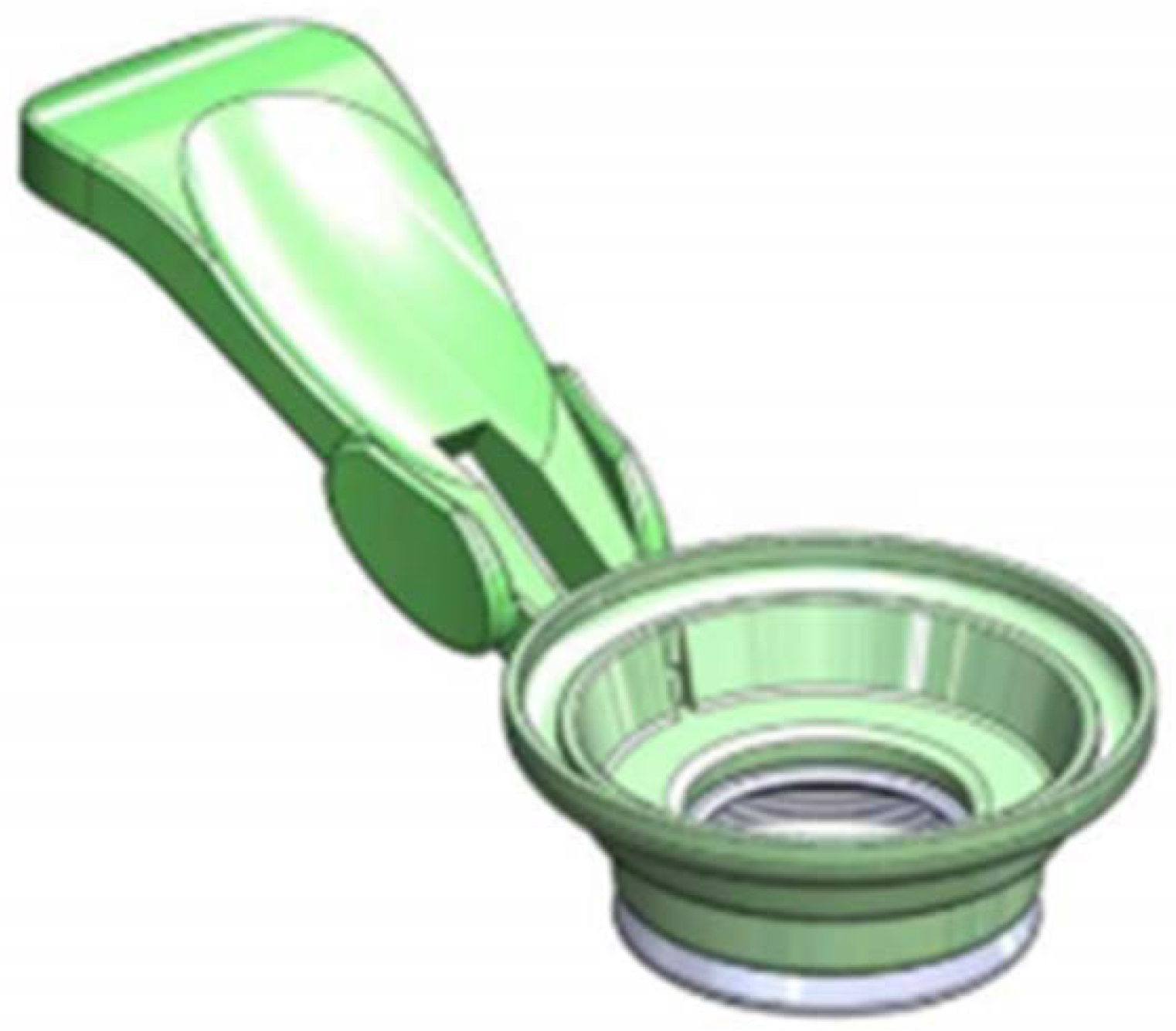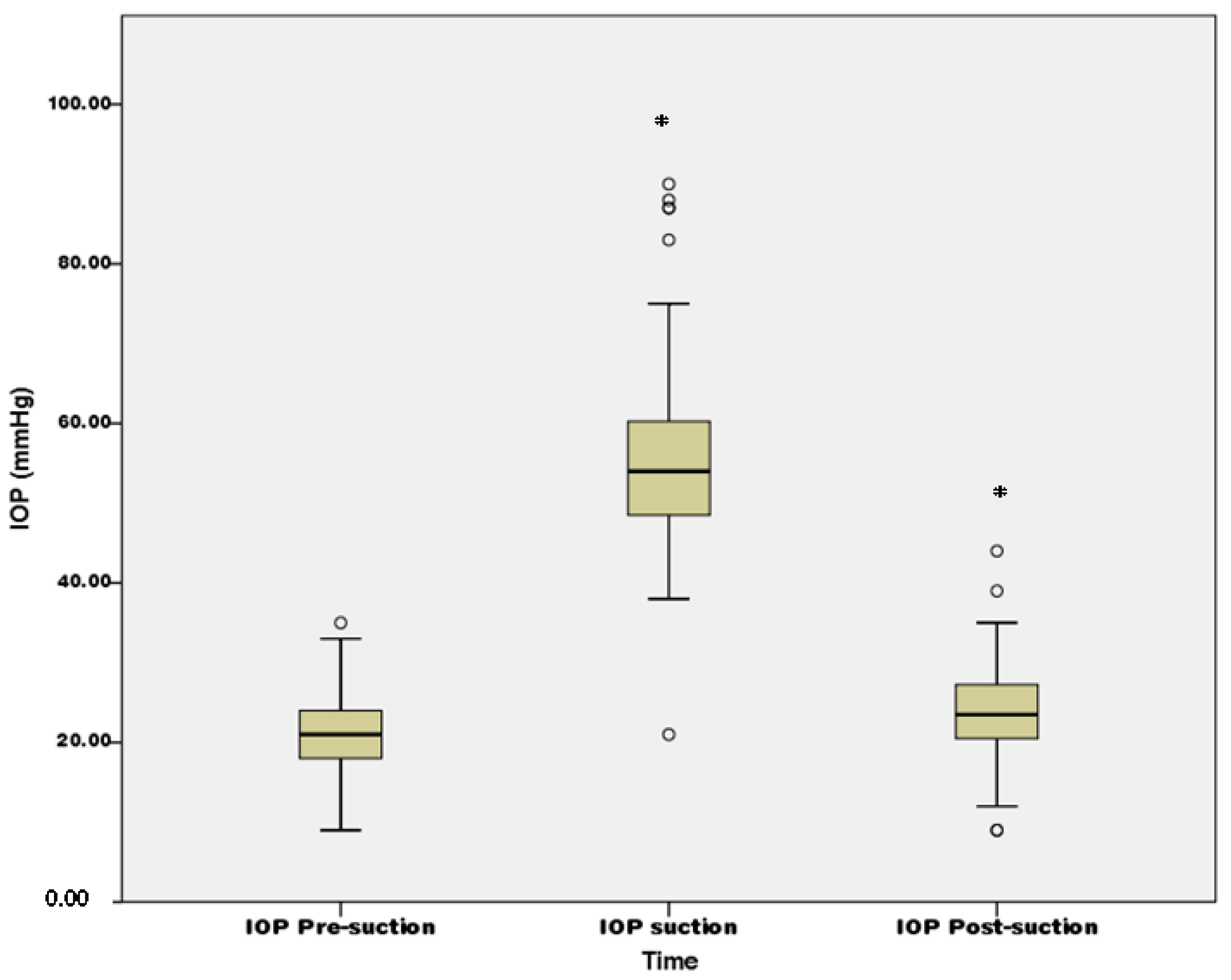Association between Ocular Parameters and Intraocular Pressure Elevation during Femtosecond Laser-Assisted Cataract Surgery in Open-Angle Glaucoma and Nonglaucoma Individuals
Abstract
1. Introduction
2. Materials and Methods
2.1. Subject Selection
2.2. Surgical Device and Technique
2.3. Main Outcome Measurement
2.4. Statistical Analysis
3. Results
4. Discussion
5. Conclusions
Author Contributions
Funding
Institutional Review Board Statement
Informed Consent Statement
Data Availability Statement
Conflicts of Interest
References
- Abouzeid, H.; Ferrini, W. Femtosecond-laser assisted cataract surgery: A review. Acta Ophthalmol. 2014, 92, 597–603. [Google Scholar] [CrossRef]
- Wei, Y.; Xu, L.; Song, H. Application of corvis st to evaluate the effect of femtosecond laser-assisted cataract surgery on corneal biomechanics. Exp. Ther. Med. 2017, 14, 1626–1632. [Google Scholar] [CrossRef] [PubMed][Green Version]
- Abell, R.G.; Kerr, N.M.; Howie, A.R.; Mustaffa Kamal, M.A.; Allen, P.L.; Vote, B.J. Effect of femtosecond laser-assisted cataract surgery on the corneal endothelium. J. Cataract. Refract. Surg. 2014, 40, 1777–1783. [Google Scholar] [CrossRef] [PubMed]
- Ebner, M.; Mariacher, S.; Januschowski, K.; Boden, K.; Seuthe, A.M.; Szurman, P.; Boden, K.T. Comparison of intraocular pressure during the application of a liquid patient interface (femto ldv z8) for femtosecond laser-assisted cataract surgery using two different vacuum levels. Br. J. Ophthalmol. 2017, 101, 1138–1142. [Google Scholar] [CrossRef] [PubMed]
- Ye, Z.; Li, Z.; He, S. A meta-analysis comparing postoperative complications and outcomes of femtosecond laser-assisted cataract surgery versus conventional phacoemulsification for cataract. J. Ophthalmol. 2017, 2017, 3849152. [Google Scholar] [CrossRef]
- Roberts, H.W.; Day, A.C.; O’Brart, D.P. Femtosecond laser-assisted cataract surgery: A review. Eur. J. Ophthalmol. 2020, 30, 417–429. [Google Scholar] [CrossRef]
- Bissen-Miyajima, H.; Suzuki, S.; Ohashi, Y.; Minami, K. Experimental observation of intraocular pressure changes during microkeratome suctioning in laser in situ keratomileusis. J. Cataract. Refract. Surg. 2005, 31, 590–594. [Google Scholar] [CrossRef]
- Kerr, N.M.; Abell, R.G.; Vote, B.J.; Toh, T. Intraocular pressure during femtosecond laser pretreatment of cataract. J. Cataract. Refract. Surg. 2013, 39, 339–342. [Google Scholar] [CrossRef]
- Williams, G.P.; Ang, H.P.; George, B.L.; Liu, Y.C.; Peh, G.; Izquierdo, L.; Tan, D.T.; Mehta, J.S. Comparison of intra-ocular pressure changes with liquid or flat applanation interfaces in a femtosecond laser platform. Sci. Rep. 2015, 5, 14742. [Google Scholar] [CrossRef]
- De Giacinto, C.; D’Aloisio, R.; Bova, A.; Candian, T.; Perrotta, A.A.; Tognetto, D. Intraocular pressure changes during femtosecond laser-assisted cataract surgery: A comparison between two different patient interfaces. J. Ophthalmol. 2019, 2019, 5986895. [Google Scholar] [CrossRef]
- Kohnen, T. Interface for femtosecond laser-assisted lens surgery. J. Cataract. Refract. Surg. 2013, 39, 491–492. [Google Scholar] [CrossRef] [PubMed]
- Grewal, D.S.; Basti, S. Intraoperative reverse pupillary block during femtosecond laser-assisted cataract surgery in a patient with phacomorphic angle closure. J. Cataract. Refract. Surg. 2014, 40, 1909–1912. [Google Scholar] [CrossRef]
- Liu, C.J.; Cheng, C.Y.; Wu, C.W.; Lau, L.I.; Chou, J.C.; Hsu, W.M. Factors predicting intraocular pressure control after phacoemulsification in angle-closure glaucoma. Arch. Ophthalmol. (Chic. Ill.: 1960) 2006, 124, 1390–1394. [Google Scholar] [CrossRef] [PubMed][Green Version]
- Chang, Y.F.; Ko, Y.C.; Lau, L.I.; Liu, C.J. Verification of a formula developed to predict the postoperative intraocular pressure after cataract surgery in primary angle-closure glaucoma. J. Chin. Med. Assoc. JCMA 2016, 79, 672–677. [Google Scholar] [CrossRef][Green Version]
- Mariacher, S.; Laubichler, P.; Mariacher, M.; Wendelstein, J.; Fischinger, I.; Bolz, M. Impact of baseline iop, vacuum, and different docking mechanisms, and their interaction on iop rise in femtosecond laser-assisted refractive and cataract surgery. J. Cataract. Refract. Surg. 2019, 45, 1818–1825. [Google Scholar] [CrossRef] [PubMed]
- Mariacher, S.; Laubichler, P.; Wendelstein, J.; Mariacher, M.; Bolz, M. Preoperative intraocular pressure as a strong predictive factor for intraocular pressure rise during vacuum application in femtosecond laser-assisted cataract surgery. Acta Ophthalmol. 2019, 97, e1123–e1129. [Google Scholar] [CrossRef]
- Gaspar, R.; Pinto, L.A.; Sousa, D.C. Corneal properties and glaucoma: A review of the literature and meta-analysis. Arq. Bras. Oftalmol. 2017, 80, 202–206. [Google Scholar] [CrossRef]
- Foster, P.J.; Broadway, D.C.; Garway-Heath, D.F.; Yip, J.L.; Luben, R.; Hayat, S.; Dalzell, N.; Wareham, N.J.; Khaw, K.T. Intraocular pressure and corneal biomechanics in an adult british population: The epic-norfolk eye study. Investig. Ophthalmol. Vis. Sci. 2011, 52, 8179–8185. [Google Scholar] [CrossRef]
- Cacciamani, A.; Oddone, F.; Parravano, M.; Scarinci, F.; Di Nicola, M.; Lofoco, G. Intravitreal injection of bevacizumab: Changes in intraocular pressure related to ocular axial length. Jpn. J. Ophthalmol. 2013, 57, 63–67. [Google Scholar] [CrossRef]
- Kim, J.M.; Park, K.H.; Han, S.Y.; Kim, K.S.; Kim, D.M.; Kim, T.W.; Caprioli, J. Changes in intraocular pressure after pharmacologic pupil dilation. BMC Ophthalmol. 2012, 12, 53. [Google Scholar] [CrossRef]
- Kohlhaas, M.; Boehm, A.G.; Spoerl, E.; Pursten, A.; Grein, H.J.; Pillunat, L.E. Effect of central corneal thickness, corneal curvature, and axial length on applanation tonometry. Arch. Ophthalmol. (Chicago, Ill.: 1960) 2006, 124, 471–476. [Google Scholar] [CrossRef] [PubMed]
- Yang, Y.; Ng, T.K.; Wang, L.; Wu, N.; Xiao, M.; Sun, X.; Chen, Y. Association of 24-hour intraocular pressure fluctuation with corneal hysteresis and axial length in untreated chinese primary open-angle glaucoma patients. Transl. Vis. Sci. Technol. 2020, 9, 25. [Google Scholar] [CrossRef] [PubMed]
- Bikbov, M.M.; Gilmanshin, T.R.; Zainullin, R.M.; Kazakbaeva, G.M.; Arslangareeva, I.I.; Panda-Jonas, S.; Khikmatullin, R.I.; Aminev, S.K.; Nuriev, I.F.; Zaynetdinov, A.F.; et al. Prevalence and associated factors of glaucoma in the russian ural eye and medical study. Sci. Rep. 2020, 10, 20307. [Google Scholar] [CrossRef] [PubMed]
- Darian-Smith, E.; Howie, A.R.; Abell, R.G.; Kerr, N.; Allen, P.L.; Vote, B.J.; Toh, T. Intraocular pressure during femtosecond laser pretreatment: Comparison of glaucomatous eyes and nonglaucomatous eyes. J. Cataract. Refract. Surg. 2015, 41, 272–277. [Google Scholar] [CrossRef] [PubMed]
- Talamo, J.H.; Gooding, P.; Angeley, D.; Culbertson, W.W.; Schuele, G.; Andersen, D.; Marcellino, G.; Essock-Burns, E.; Batlle, J.; Feliz, R.; et al. Optical patient interface in femtosecond laser-assisted cataract surgery: Contact corneal applanation versus liquid immersion. J. Cataract. Refract. Surg. 2013, 39, 501–510. [Google Scholar] [CrossRef]
- Sperl, P.; Strohmaier, C.; Kraker, H.; Motloch, K.; Lenzhofer, M.; Moussa, S.; Reitsamer, H.A. Intraocular pressure course during the femtosecond laser-assisted cataract surgery in porcine cadaver eyes. Investig. Ophthalmol. Vis. Sci. 2017, 58, 6457–6461. [Google Scholar] [CrossRef]
- Doughty, M.J.; Zaman, M.L. Human corneal thickness and its impact on intraocular pressure measures: A review and meta-analysis approach. Surv. Ophthalmol. 2000, 44, 367–408. [Google Scholar] [CrossRef]
- Furlanetto, R.L.; Facio, A.C., Jr.; Hatanaka, M.; Susanna Junior, R. Correlation between central corneal thickness and intraocular pressure peak and fluctuation during the water drinking test in glaucoma patients. Clinics (Sao Paulo) 2010, 65, 967–970. [Google Scholar] [CrossRef]
- Baig, N.B.; Cheng, G.P.; Lam, J.K.; Jhanji, V.; Chong, K.K.; Woo, V.C.; Tham, C.C. Intraocular pressure profiles during femtosecond laser-assisted cataract surgery. J. Cataract. Refract. Surg. 2014, 40, 1784–1789. [Google Scholar] [CrossRef]
- Ibarz, M.; Hernandez-Verdejo, J.L.; Bolivar, G.; Tana, P.; Rodriguez-Prats, J.L.; Teus, M.A. Porcine model to evaluate real-time intraocular pressure during femtosecond laser cataract surgery. Curr. Eye Res. 2016, 41, 507–512. [Google Scholar] [CrossRef]
- Schultz, T.; Conrad-Hengerer, I.; Hengerer, F.H.; Dick, H.B. Intraocular pressure variation during femtosecond laser-assisted cataract surgery using a fluid-filled interface. J. Cataract. Refract. Surg. 2013, 39, 22–27. [Google Scholar] [CrossRef] [PubMed]



| Characteristics | Study Population (N = 103) |
|---|---|
| Age (years, mean ± SD) | 66.72 ± 12.60 |
| Sex (male/female) | 52:51 |
| Laterality (right/left) | 58:45 |
| Systemic disease (N) # | |
| 0 | 91 |
| 1 | 9 |
| ≥2 | 3 |
| Glaucoma (N) | 12 |
| Ocular parameters (mean ± SD) | |
| Presuction IOP (mmHg) | 20.96 ± 4.79 |
| PPS (mm) | 6.70 ± 0.74 |
| ACD (mm) | 2.89 ± 0.56 |
| CCT (µm) | 543.98 ± 35.09 |
| AL (mm) | 25.46 ± 2.70 |
| ST (second) | 154.68 ± 23.24 |
| Parameters | aOR | 95% CI | p Value | ||
|---|---|---|---|---|---|
| Lower Limit | Upper Limit | Raw | Bonferroni Adjustment | ||
| Presuction IOP | 2.399 | 1.770 | 8.521 | 0.023 * | 0.038 * |
| PPS | 4.833 | 2.418 | 9.660 | <0.001 * | 0.006 * |
| ACD | 1.269 | 0.391 | 4.118 | 0.964 | 1.000 |
| CCT | 5.551 | 1.577 | 9.541 | 0.002 * | 0.012 * |
| AL | 0.020 | 0.008 | 0.699 | 0.037 * | 0.042 * |
| ST | 1.441 | 0.645 | 3.244 | 0.071 | 0.426 |
| Parameters | aOR (95% CI) | p Value | |||
|---|---|---|---|---|---|
| OAG Subgroups (N = 12) | Nonglaucoma Subgroup (N = 91) | OAG to Nonglaucoma | Raw | Bonferroni Adjustment | |
| Presuction IOP | 2.687 (1.520–4.365) # | 2.225 (1.831–4.663) # | 1.084 (0.743–1.581) | 0.677 | 0.993 |
| PPS | 6.477 (2.269–11.584) # | 3.912 (1.999–10.416) # | 1.860 (0.181–9.123) | 0.602 | 0.834 |
| ACD | 1.752 (0.460–5.103) | 1.093 (0.281–4.017) | 2.421 (0.073–8.041) | 0.621 | 0.918 |
| CCT | 5.823 (1.084–10.248) # | 5.485 (1.226–9.359) # | 1.029 (0.977–1.083) | 0.278 | 0.552 |
| AL | 0.007 (0.001–0.176) # | 0.034 (0.009–0.752) # | 0.231 (0.106–0.502) | <0.001 * | 0.006 * |
| ST | 1.383 (0.534–3.160) | 1.488 (0.669–3.833) | 0.978 (0.906–1.056) | 0.574 | 0.767 |
Publisher’s Note: MDPI stays neutral with regard to jurisdictional claims in published maps and institutional affiliations. |
© 2022 by the authors. Licensee MDPI, Basel, Switzerland. This article is an open access article distributed under the terms and conditions of the Creative Commons Attribution (CC BY) license (https://creativecommons.org/licenses/by/4.0/).
Share and Cite
Wang, Y.-H.; He, Y.-Z.; Chiang, M.-H.; Lee, C.-Y.; Wu, C.-L. Association between Ocular Parameters and Intraocular Pressure Elevation during Femtosecond Laser-Assisted Cataract Surgery in Open-Angle Glaucoma and Nonglaucoma Individuals. J. Pers. Med. 2022, 12, 257. https://doi.org/10.3390/jpm12020257
Wang Y-H, He Y-Z, Chiang M-H, Lee C-Y, Wu C-L. Association between Ocular Parameters and Intraocular Pressure Elevation during Femtosecond Laser-Assisted Cataract Surgery in Open-Angle Glaucoma and Nonglaucoma Individuals. Journal of Personalized Medicine. 2022; 12(2):257. https://doi.org/10.3390/jpm12020257
Chicago/Turabian StyleWang, Ya-Hui, Yi-Zhen He, Ming-Hsuan Chiang, Chia-Yi Lee, and Chien-Liang Wu. 2022. "Association between Ocular Parameters and Intraocular Pressure Elevation during Femtosecond Laser-Assisted Cataract Surgery in Open-Angle Glaucoma and Nonglaucoma Individuals" Journal of Personalized Medicine 12, no. 2: 257. https://doi.org/10.3390/jpm12020257
APA StyleWang, Y.-H., He, Y.-Z., Chiang, M.-H., Lee, C.-Y., & Wu, C.-L. (2022). Association between Ocular Parameters and Intraocular Pressure Elevation during Femtosecond Laser-Assisted Cataract Surgery in Open-Angle Glaucoma and Nonglaucoma Individuals. Journal of Personalized Medicine, 12(2), 257. https://doi.org/10.3390/jpm12020257






